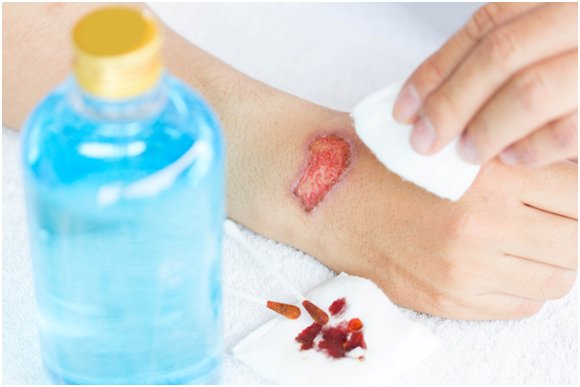Last week, Dorothy, 85 years young, showed me a red, shallow open wound on her shin.
“I peeled the skin off a couple of weeks ago, and it’s still oozing. Why isn’t it getting any better?
I asked, “How have you been treating it up to now?”
“I keep it clean with peroxide twice a day and put a bandage over it at night to protect my sheets. I can’t understand why it hasn’t healed yet. Is that because I’m older now, and on a blood thinner?”
“Not necessarily. It might be because you’re just not giving it a chance to heal.”
“But I’m keeping it nice and clean! Isn’t that what hydrogen peroxide does?
“Using hydrogen peroxide works fine to clean up a new cut, scrape or tear. The problem is using peroxide to clean your wound every day after the first time. Hydrogen peroxide will actually injureany new tissue trying to grow. Every time you clean your wound using peroxide, you’re actually harming it. That’s why it’s not healing.”
“What about using rubbing alcohol, instead?”
“Using rubbing alcohol for cleaning cuts isn’t any better than using the hydrogen peroxide. Using rubbing alcohol to clean a cut or open soredoesn’t clean it any better than soapy water. It causes more problems for you as well as stings like blazes.”
Like hydrogen peroxide, both ethyl alcohol and isopropyl alcohol work just fine to clean intact skin, but using either of them on open cuts or wounds actually damages your cells and slows down healing.
When bumped or scraped against something hard, seniors’ skin is more fragile and will often tear instead of cut. Once you’ve cleaned the wound well the first time, don’t scrub it again or use rubbing alcohol or hydrogen peroxide to “keep it clean.” Using those chemicals won’t help. Instead, they slowdown the healing process by damaging the cells trying to grow back.
If your “owie” is deep or bleeding profusely, seek immediate medical attention. Otherwise, you can usually treat a simple skin tear successfully by using a moist, transparent dressing.
For faster wound healing and to prevent scarring, a little moisture is a good thing. For senior skin that rips easily, a thin transparent dressing like Tegaderm® often works amazingly well. Cleaning well, then using a transparent dressing can save that “peeled back” layer of skin and speed up the healing process.
Tegaderm® and other special dressings are available in most pharmacies and in all medical supply stores.
Here are 7 Steps to Treating a Skin Tear:
- Wash it gently.
Carefully wash the ripped skin and area around it with soapy water. Don’t rub and scrub, and avoid using disinfectants like hydrogen peroxide or rubbing alcohol. Those cleaners don’t remove bacteria any better than soap and water, and can actually make your wound worse.
- Apply direct pressure to stop any bleeding.
Press down firmly on the wound with gauze or a towel for at least a minute. Avoid the temptation to peek; this lets up on the pressure and can cause bleeding can start up again. Applying pressure to the wound stimulates your clotting factors to stop bleeding more quickly. Ice and elevation also help reduce bleeding.
- Lay the ripped skin layer back down.
Carefully put the torn skin back in place, matching the edges as best you can.This prevents having an open wound, which will take much longer to heal. If your skin flap is still attached, laying the skin back down will allow it to heal without scarring.
- Cover the wound with a transparent dressing like Tegaderm®.
Tegaderm® is a transparent, water-resistant dressing that protects wounds while they heal. It will keep any skin flap in place, protect it from dirt and bacteria, and keep it moist, promoting healing.
- Leave the transparent dressing on for at least 2 to 3 days.
Tegaderm® dressings allow the skin to breathe and are best left in place for several days before changing. You should check it every day and replace it if you see lots of blood or fluid pooling underneath. To remove Tegaderm® dressing, slowly peel off the used dressing, then blot away excess fluid or blood by gently patting the area with clean gauze or towel. If you’re using an antibiotic ointment, reapply it before putting on a new dressing.
- Add padding over the dressing if needed.
If you need additional cushioning to protect areas on forearms, elbows, or shins from bumps, you can add padding over the dressing for protection.
- Seek medical attention if needed.
Call your doctor if you notice pus or excessive fluid collecting under the wound dressing or if the area becomes painful. If your wound doesn’t improve despite these steps or you suspect that it’s deeper than just skin peeled off, seek medical attention. You may need stitches or an antibiotic.


